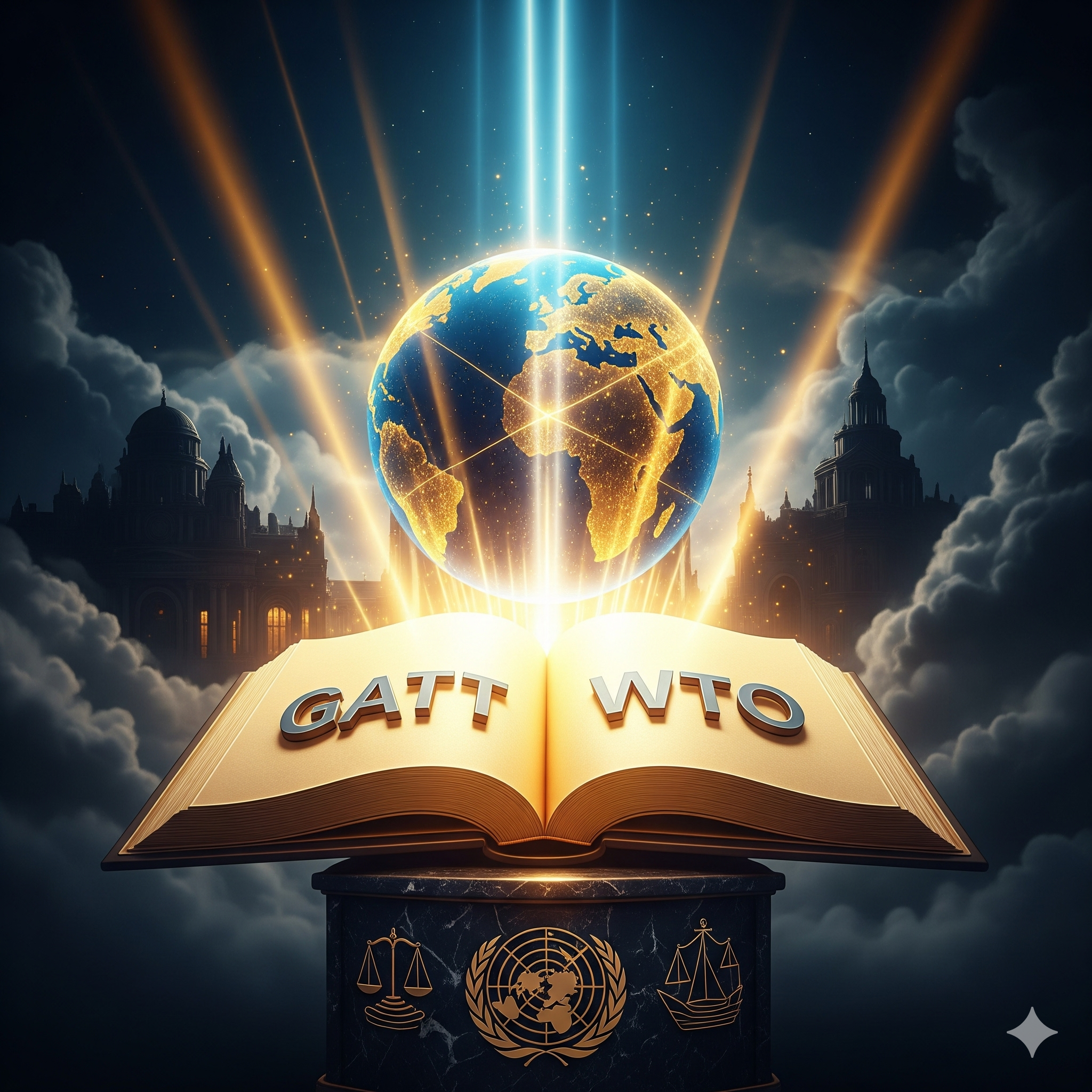Introduction
International trade is the backbone of modern globalization, and its regulation has been one of the most significant challenges since the 20th century. Countries often face conflicts over tariffs, subsidies, and trade restrictions, which, if unresolved, can escalate into trade wars. To prevent such outcomes and promote a rules-based system of trade, global institutions have evolved over time. Two of the most critical in this regard are the General Agreement on Tariffs and Trade (GATT) and its successor, the World Trade Organization (WTO).
The Uruguay Round (1986–1994) was a landmark event that not only expanded the scope of trade negotiations beyond goods but also led to the establishment of the WTO. Understanding the role of GATT, the significance of the Uruguay Round, and the creation of the WTO is crucial to grasp the dynamics of international trade today.
Historical Background of GATT
The origins of GATT can be traced back to the aftermath of World War II. The devastation of war had severely disrupted trade and economies, prompting nations to explore mechanisms for global cooperation. Initially, the International Trade Organization (ITO) was proposed under the Havana Charter in 1948. However, due to the U.S. Congress’s refusal to ratify it, the ITO never came into force.
Instead, in 1947, 23 countries signed the General Agreement on Tariffs and Trade (GATT) in Geneva as a temporary arrangement to reduce tariffs and trade barriers. Over time, GATT became the de facto global institution for trade negotiations and dispute settlement. It was not a permanent organization but rather a legal agreement, administered through rounds of negotiations.
Key objectives of GATT included:
- Reduction of tariffs and customs duties.
- Elimination of discriminatory trade practices.
- Ensuring non-discrimination through the Most Favoured Nation (MFN) principle.
- Providing a platform for settling trade disputes.
Functioning of GATT
GATT was essentially a set of rules and procedures with no permanent institutional structure. Its decisions were made during trade rounds, where member nations negotiated reductions in tariffs and other trade barriers.
The initial rounds focused primarily on tariff reduction, but later rounds dealt with more complex issues such as subsidies, non-tariff barriers, and agricultural trade. GATT functioned on two key principles:
- Most Favoured Nation (MFN) Principle: Any trade concession granted to one member had to be extended to all others.
- National Treatment Principle: Imported goods could not be discriminated against once they entered the domestic market.
Despite successes, GATT faced criticisms, particularly its inability to effectively regulate agriculture, services, and intellectual property rights. Moreover, dispute resolution under GATT was slow and often blocked by countries unwilling to comply with rulings.
Rounds of Negotiations under GATT
Between 1947 and 1994, eight major negotiation rounds were held:
- Geneva Round (1947): 23 countries; focused on tariff reductions.
- Annecy Round (1949): Added new countries; further tariff cuts.
- Torquay Round (1951): Expanded coverage of tariff concessions.
- Geneva Round (1956): Continued tariff negotiations.
- Dillon Round (1960–61): Addressed European Economic Community (EEC) tariff issues.
- Kennedy Round (1964–67): Introduced the first major agreement on anti-dumping.
- Tokyo Round (1973–79): Expanded to non-tariff measures, government procurement, and subsidies.
- Uruguay Round (1986–94): Most ambitious; led to WTO creation.
Among these, the Uruguay Round stands out as the most significant milestone.
The Uruguay Round (1986–1994)
The Uruguay Round was launched in Punta del Este, Uruguay, in September 1986, involving 123 member countries—making it the most comprehensive negotiation round in GATT history. Its agenda went far beyond traditional tariff reductions.
Objectives of the Uruguay Round:
- Reduce tariffs and non-tariff barriers.
- Bring agriculture and textiles under multilateral discipline.
- Address trade in services (previously excluded).
- Establish rules for intellectual property protection (IPR).
- Reform dispute settlement mechanisms.
- Move towards a permanent institutional framework for trade.
Major Outcomes of the Uruguay Round:
- Agricultural Trade Reform:
- Agriculture, a highly sensitive area, was brought under multilateral trade rules for the first time.
- Commitments were made to reduce subsidies, tariffs, and quantitative restrictions.
- Agriculture, a highly sensitive area, was brought under multilateral trade rules for the first time.
- Textiles and Clothing:
- The Multi-Fibre Arrangement (MFA), which allowed developed countries to restrict imports of textiles, was phased out over ten years.
- This greatly benefited developing countries, including India.
- The Multi-Fibre Arrangement (MFA), which allowed developed countries to restrict imports of textiles, was phased out over ten years.
- Trade in Services (GATS):
- The General Agreement on Trade in Services (GATS) was created to govern sectors like banking, insurance, telecommunications, and professional services.
- It was the first global framework for services liberalization.
- The General Agreement on Trade in Services (GATS) was created to govern sectors like banking, insurance, telecommunications, and professional services.
- Intellectual Property Rights (TRIPS):
- The Agreement on Trade-Related Aspects of Intellectual Property Rights (TRIPS) established minimum standards for patents, copyrights, trademarks, and related rights.
- It was a breakthrough but also controversial, as developing nations feared restrictions on affordable medicines and traditional knowledge.
- The Agreement on Trade-Related Aspects of Intellectual Property Rights (TRIPS) established minimum standards for patents, copyrights, trademarks, and related rights.
- Dispute Settlement Understanding (DSU):
- The Uruguay Round created a stronger dispute resolution system with clear timelines and binding rulings.
- This addressed GATT’s earlier weakness, where powerful nations could block decisions.
- The Uruguay Round created a stronger dispute resolution system with clear timelines and binding rulings.
- Creation of the WTO:
- The Uruguay Round culminated in the signing of the Marrakesh Agreement in April 1994.
- This led to the formal establishment of the World Trade Organization (WTO) on 1 January 1995.
- Unlike GATT, the WTO was a permanent organization with legal authority over trade rules.
- The Uruguay Round culminated in the signing of the Marrakesh Agreement in April 1994.
Establishment of the World Trade Organization
The WTO replaced GATT as the institutional framework governing global trade. While GATT rules still remain in force, they now exist under the umbrella of the WTO agreements.
Key features of the WTO:
- Permanent Organization: Unlike GATT, it has a structured secretariat in Geneva.
- Wider Coverage: Includes goods, services, and intellectual property.
- Binding Dispute Resolution: Ensures compliance by members.
- Equal Platform: Decisions are taken through consensus, giving developing nations more voice.
Currently, the WTO has 164 members (as of 2025), making it nearly universal.
Impact of the Uruguay Round and WTO on Developing Countries
The Uruguay Round and the creation of the WTO had mixed consequences for developing nations like India.
Positive Impacts:
- Increased market access in developed countries, especially in textiles and agricultural products.
- Stronger dispute resolution system gave smaller countries legal means to challenge unfair practices.
- Opportunities to expand trade in services, particularly IT and outsourcing.
Challenges:
- TRIPS obligations raised concerns about access to affordable medicines.
- Pressure on domestic industries due to competition from global players.
- Agricultural reforms often favored developed countries, which continued to maintain hidden subsidies.
India and the Uruguay Round
India was an active participant in the Uruguay Round and played a critical role in voicing concerns of developing nations.
- Initially, India opposed inclusion of services and intellectual property in trade talks, arguing that they were not traditional trade issues.
- However, India later accepted the agreements, while seeking safeguards for its domestic industries and agricultural sector.
- India benefited significantly in textiles and IT services but faced challenges in agriculture and pharmaceuticals.
Criticism of the Uruguay Round
While hailed as historic, the Uruguay Round also attracted criticism:
- Developed countries continued to use non-tariff barriers even after tariff reductions.
- TRIPS agreement was seen as favoring multinational corporations.
- Liberalization often increased inequality within and among nations.
- Agricultural subsidies in developed countries (like EU’s CAP and U.S. farm subsidies) remained high, hurting developing nations’ farmers.
Legacy and Future Challenges
The Uruguay Round fundamentally transformed the global trading system by creating a legally binding and institutional framework under the WTO. However, subsequent trade rounds, like the Doha Development Round (2001–present), have faced deadlock due to disagreements between developed and developing countries.
Looking ahead, challenges such as digital trade, climate-linked trade measures, and protectionism are testing the adaptability of the WTO framework. The Uruguay Round’s legacy remains central to understanding these issues, as it laid the foundation for a rules-based system that continues to evolve.
Conclusion
The journey from GATT to WTO through the Uruguay Round represents a critical chapter in global economic history. What began as a temporary agreement among 23 countries in 1947 evolved into a comprehensive institution governing global trade with 164 members. The Uruguay Round expanded trade rules into new areas, strengthened dispute resolution, and established the WTO as a permanent body.
For countries like India, the Uruguay Round brought both opportunities and challenges. While sectors like textiles, IT services, and exports benefited, issues around agriculture and intellectual property remain contentious.
Ultimately, the Uruguay Round and WTO highlight the delicate balance between free trade, fair competition, and national interests. For students and policymakers, understanding this evolution is essential to navigating the complexities of global trade today




